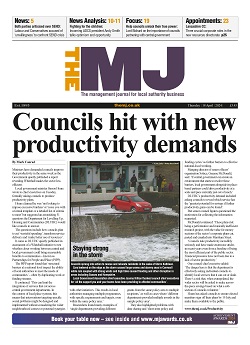In our busy inner-city-borough, residents are settling into new council homes on the King Square Estate, a short walk from Old Street in central London.
After years of careful planning and working alongside the people already living on our estate, we at Islington LBC have built 93 badly-needed new genuinely affordable council homes. Each one of these homes, built to a high standard with green roofs and solar panels, is vital in the face of our city’s ongoing housing crisis. But the new social housing is only half the story at King Square.
Perhaps surprisingly, we have also added 1,695 square metres of green space to our estate – more than a quarter the size of a football pitch – in central London. We did this by rethinking the estate layout, and replaced old hardstanding areas with new open space, including a line of new trees running through the heart of the estate. We have also built a new community centre, refurbished a children’s nursery, added more than 200 bike spaces, installed new lighting and more.
This approach – building new council homes for our estates alongside major, tangible improvements to our estates for everyone to use and enjoy, is central to the way we are building new council homes in Islington.
We are in the middle of our biggest council house-building programme for a generation, as we strive to create safe, decent and genuinely affordable homes. In all, we completed 33 different council home development schemes since 2010, some big, some very small, each of them important to local residents, who have priority for the new homes under our Local Lettings Policy. Seventy eight per cent of the homes we have developed are council homes for social rent.
From the start, our housebuilding programme has sought to improve estates alongside creating more homes. We have always known that building new council homes is as much about building communities as it is about building each home, and improvements to our estates have been a central part of our housebuilding programme.
For example, on our Dover Court Estate, we built 57 new council homes as part of a much wider project that has also transformed public space. An old sunken football pitch, that used to attract anti-social behaviour, has been transformed into an attractive green space, with a much-improved pitch on another part of the estate. We also created a new accessible community space, which opens onto a popular new playground for children, in one of our existing blocks on the estate.
Central to all the work we do is our relationship with residents already living there. They know their estates inside-out, the good bits and the bad, and how the estate as a whole can benefit from the work being done to create more social housing.
When we start talking to residents, we have some ideas about how we can create more council homes and also make their estate work better for everyone. But their feedback, comments and suggestions are a vital part of the process. At Dover Court, the residents’ association suggested transforming underused storage space into the new community space, where residents can come together, and children on the estate told us what play equipment would be best.
After delivering 550 council homes, we committed to building another 750 homes. As the most densely populated area of the country, we have to be sensitive and creative about our use of land. It is important to us to build as many affordable homes as possible given our space constraints and local housing need.
We make the schemes stack up financially largely by building on land the council already owns. We use grant or right-to-buy receipts, and enough open market sale homes to fully fund the development. We have an in-house newbuild service and procure our contractors for each scheme through a framework we developed. This allows us to maximise the number of homes for social rent, invest in affected estates, while continuing to invest our Housing Revenue Account into safe, well-maintained and energy- efficient homes in the rest of our stock.
The new development projects will include further improvements to estates. We are also conscious of the importance of improving our estates that are not part of our newbuild programme. So, alongside, we are spending an extra £10m to further transform shared spaces, including more greenery, better landscaping, storage, playgrounds and outdoor gyms.
Every new council home we build individually transforms lives – for its new tenants, the people who can move into the home they have recently left, and so on down the chain. It is also vital that we bring collective improvements for our communities – new playgrounds, pitches, trees and shrubs – so our neighbourhoods grow alongside the residents who live in them.
For the people living in our estates – whether in new housing or existing housing – better playgrounds, high-quality spaces and trees are as important to creating good-quality communities and homes as the bricks and mortar of the new homes themselves.
Maxine Holdsworth is corporate director for homes and neighbourhood at Islington LBC
@IslingtonBC

